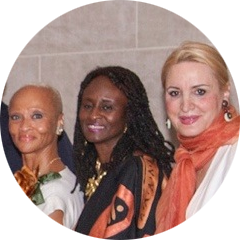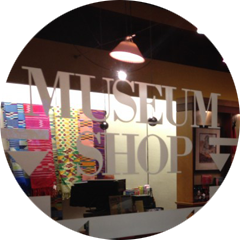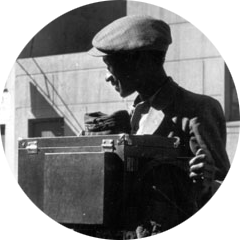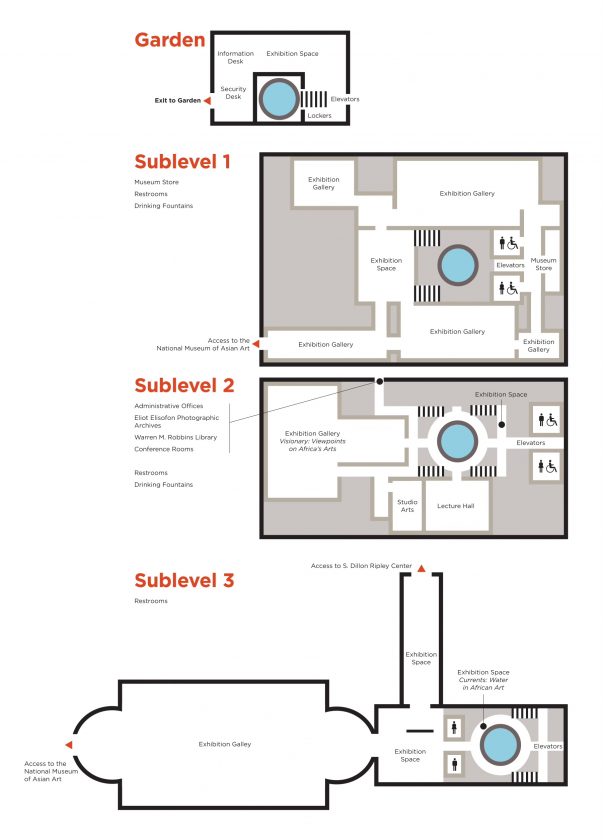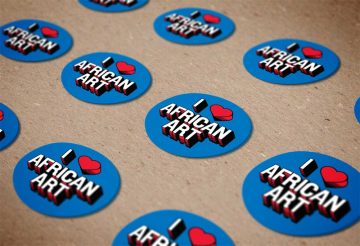Welcome home!
National Museum of African Art
950 Independence Ave SW
Open every day 10 a.m. to 5:30 p.m.
Admission is free.
Visitor Information
Personal belongings and bags are subject to a thorough search; we encourage visitors to limit the number of personal belongings they bring into our facility.
Museum Floor Plan
Click on image for larger view.
NMAfA Docents
Welcome docents! Please refer to this site to find materials and recordings from our in-service sessions as well as resources to use for your tours. The front page features a blog function through which docents may write about their travels, their research, or other topics related to African art & culture.
Radio Africa
The sounds that make up the diverse music of Africa are now yours to explore. Radio Africa streams, at no charge, complete tracks from the collections of Smithsonian Folkways.
From the rhythms of Benin to the wedding music of Ethiopia to the traditional Zulu music of South Africa to the parade music of Senegal, you’ll never know what you’ll hear next!
Click the Recording Info button on the radio for more information about the music or to purchase a track from Smithsonian Folkways.
Docent-led tours
Docent-led, walk-n tours are available throughout the week. All tours are subject to docent availability, and last-minute cancellations may occur. Check NMAFA’s calendar for dates and times. Tours meet at the Information Desk in the Pavilion on the ground floor. Additional tours may be offered. Please ask the volunteer at the Information Desk about availability of additional tours.
Mission Statement
To be a 21st Century Global African Art Museum
- Museum History
- Video History of the Museum
- Directions and Transportation
- Dining, Museum Store, and Photo Policies
- Support Us
Museum History
The National Museum of African Art (NMAfA) began as a private educational institution in 1964 to promote cross-cultural understanding in the social sciences and arts. Founded by Warren M. Robbins, a former U.S. Foreign Service officer, it was known as the Museum of African Art and located on Capitol Hill in a townhouse that had been the home of Frederick Douglass, the African American abolitionist and statesman. In August 1979, by enactment of Public Law 95-414, the museum became part of the Smithsonian Institution, the world’s largest museum and research complex dedicated to the increase and diffusion of knowledge.
The museum, formally renamed the National Museum of African Art in 1981, opened to the public in a new facility on the National Mall in 1987. Initially focused on the traditional arts of sub-Saharan Africa, NMAfA broadened its collecting scope and programs to include both modern and contemporary artworks, distinguishing itself as the first museum in the United States to include a sustained focus on modern and contemporary African art in its mission.
Through its collections research facilities, state-of-the-art conservation lab, groundbreaking exhibitions, educational outreach and public programs, the museum has expanded the parameters of the field of African art history and presented to the public a rich diversity of artistic traditions from throughout continent. The museum’s programs target audiences of all ages and offer a multifaceted view of Africa’s artistic traditions by incorporating cutting edge, contemporary and urban-focused performances and programs. Artist talks, films and lectures draw African art enthusiasts, area students, artists and collectors as well as individuals from the immigrant and expatriate communities. Let’s Read about Africa introduces children to current and classical literature about Africa; Studio Africa creates a comprehensive learning environment for DC-public schoolchildren by exploring African art and cultures through monthly workshops and hands-on activities; and the culinary program offers cooking demonstrations and tasting events that take inspiration from the museum’s exhibition program.
Warren Robbins’ inaugural vision—to teach visitors how to look at African art in the interest of promoting cross-cultural communication—remains at the heart of the National Museum of African Art’s mission today. Indeed, the museum will remain relevant to its diverse audiences and African constituents as it continues to promote and represent the rich artistic practices of Africa.
A Video History of the Museum
(Best played in fullscreen. Use the expanded button at the bottom right of the video)
Warren Robbins
 Robbins’ passion for African art, and subsequent collecting, was first ignited by the purchase of a carved Yoruba sculpture he found in Germany during his tenure as a State Department public affairs officer and cultural attaché. Returning to the United States in 1960 as the civil rights movement was emerging, Robbins proposed using African art to highlight Africa’s rich heritage and encourage conversations about race and other topics involving the continent. In 1963 he established the Center for Cross-Cultural Communication to “show the rich creative heritage of Africa, and to underscore the implications of this heritage in America’s quest for interracial understanding.” He firmly believed that increased communication would improve tolerance and understanding across diverse communities.
Robbins’ passion for African art, and subsequent collecting, was first ignited by the purchase of a carved Yoruba sculpture he found in Germany during his tenure as a State Department public affairs officer and cultural attaché. Returning to the United States in 1960 as the civil rights movement was emerging, Robbins proposed using African art to highlight Africa’s rich heritage and encourage conversations about race and other topics involving the continent. In 1963 he established the Center for Cross-Cultural Communication to “show the rich creative heritage of Africa, and to underscore the implications of this heritage in America’s quest for interracial understanding.” He firmly believed that increased communication would improve tolerance and understanding across diverse communities.
Read more
Lydia Puccinelli-Robbins

Photograph by Brad Simpson
Born December 7, 1930, in Pittsburgh, Pennsylvania, Lydia demonstrated a talent for drawing and painting. Her love of art and its creative and expressive possibilities drew her to New York, where in 1959 she graduated from the School of Art, Cooper Union, with a degree in painting. After studying painting with Larry Day at the Aspen School of Art in Colorado, she became a textile designer creating designs for large American textile firms and department stores, notably through the Nina Lewin and the Paul Hargittal studios.
A call from a long-time friend in 1966 led to her involvement with African art. Joining the new African Art Museum on Capitol Hill, in Washington D.C., Lydia worked alongside founder Warren Robbins through the museum’s growth and development, from its establishment in the Frederick Douglass house on A Street to its incorporation into the Smithsonian Institution as the National Museum of African Art in 1979 through an act of Congress and beyond. Throughout the years, she held a variety of posts including exhibition designer, curatorial assistant, registrar, curator of exhibitions and of collections, retiring from the Smithsonian in 2000 as curator. She designed over 75 exhibitions, wrote numerous publications, and visited Africa in 1974 and 1981. She interacted with a broad social milieu that extended from village artisans to African nobility, world-renowned artists, Hollywood movie stars, iconic statesmen, and U.S. presidents.
Upon retirement, Lydia pursued her lifelong love of travel and volunteered at the Robbins Center for Cross-Cultural Communication. She and Robbins married in 2008. Upon his death, she oversaw the distribution of the center’s holdings to museums and HBCUs.
Directions
The National Museum of African Art is located on the National Mall between the Smithsonian’s Arts & Industries Building and the Sackler Gallery of Art. The main entranceto the museum is located in the Enid Haupt Garden on Independence Avenue.
Map of the Smithsonian Institution
Metro
Smithsonian Station (Blue and Orange lines); exit on the National Mall or on Independence Avenue.
L’Enfant Plaza Station (all lines except Red); exit Maryland Avenue/Smithsonian Museums
Parking and transportation
Street parking is limited and posted times are enforced. Use public transportation or taxis as an alternate means of travel.
We invite you to try Metrorail and Metrobus, Washington, D.C.’s transit system.
Dining
African Art does not have a dining facility on site. There are, however, many places to eat in and around the Smithsonian Institution
Museum Store
Open 10 a.m.-5:15 p.m.
202.633.0030
The Museum Store offers a wide selection of merchandise inspired by the collections and the arts and cultures of Africa.
Gallery Guidelines
Support Us
Join us today and make a lasting contribution to the future of the National Museum of African Art. In an economy of shrinking federal assistance, your support provides the vital resources necessary to sustain and develop our exhibitions and programs.

